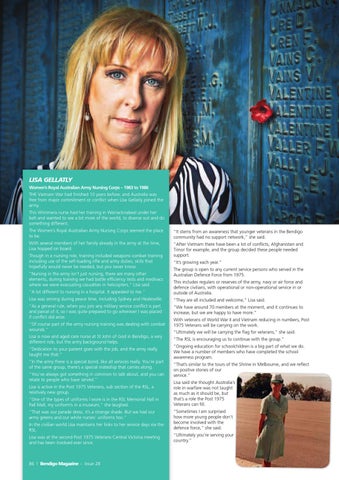Lisa Gellatly Women’s Royal Australian Army Nursing Corps – 1983 to 1986 THE Vietnam War had finished 10 years before, and Australia was free from major commitment or conflict when Lisa Gellatly joined the army. This Wimmera nurse had her training in Warracknabeal under her belt and wanted to see a bit more of the world, to diverse out and do something different. The Women’s Royal Australian Army Nursing Corps seemed the place to be.
“It stems from an awareness that younger veterans in the Bendigo community had no support network,” she said.
With several members of her family already in the army at the time, Lisa hopped on board.
“After Vietnam there have been a lot of conflicts, Afghanistan and Timor for example, and the group decided these people needed support.
Though in a nursing role, training included weapons combat training including use of the self-loading rifle and army duties, skills that hopefully would never be needed, but you never know. “Nursing in the army isn’t just nursing, there are many other elements, during training we had battle efficiency tests and medivacs where we were evacuating casualties in helicopters,” Lisa said.
“It’s growing each year.” The group is open to any current service persons who served in the Australian Defence Force from 1975.
“A lot different to nursing in a hospital. It appealed to me.”
This includes regulars or reserves of the army, navy or air force and defence civilians, with operational or non-operational service in or outside of Australia.
Lisa was serving during peace time, including Sydney and Healesville.
“They are all included and welcome,” Lisa said.
“As a general rule, when you join any military service conflict is part and parcel of it, so I was quite prepared to go wherever I was placed if conflict did arise.
“We have around 70 members at the moment, and it continues to increase, but we are happy to have more.”
“Of course part of the army nursing training was dealing with combat wounds.” Lisa is now and aged care nurse at St John of God in Bendigo, a very different role, but the army background helps. “Dedication to your patient goes with the job, and the army really taught me that.” “In the army there is a special bond, like all services really. You’re part of the same group, there’s a special mateship that carries along. “You’ve always got something in common to talk about, and you can relate to people who have served.” Lisa is active in the Post 1975 Veterans, sub section of the RSL, a relatively new group. “One of the types of uniforms I wore is in the RSL Memorial Hall in Pall Mall, my uniform’s in a museum,” she laughed. “That was our parade dress, it’s a strange shade. But we had our army greens and our white nurses’ uniforms too.” In the civilian world Lisa maintains her links to her service days via the RSL. Lisa was at the second Post 1975 Veterans Central Victoria meeting and has been involved ever since.
86 | Bendigo Magazine - Issue 28
With veterans of World War II and Vietnam reducing in numbers, Post 1975 Veterans will be carrying on the work. “Ultimately we will be carrying the flag for veterans,” she said. “The RSL is encouraging us to continue with the group.” “Ongoing education for schoolchildren is a big part of what we do. We have a number of members who have completed the school awareness program. “That’s similar to the tours of the Shrine in Melbourne, and we reflect on positive stories of our service.” Lisa said she thought Australia’s role in warfare was not taught as much as it should be, but that’s a role the Post 1975 Veterans can fill. “Sometimes I am surprised how more young people don’t become involved with the defence force,” she said. “Ultimately you’re serving your country.”
